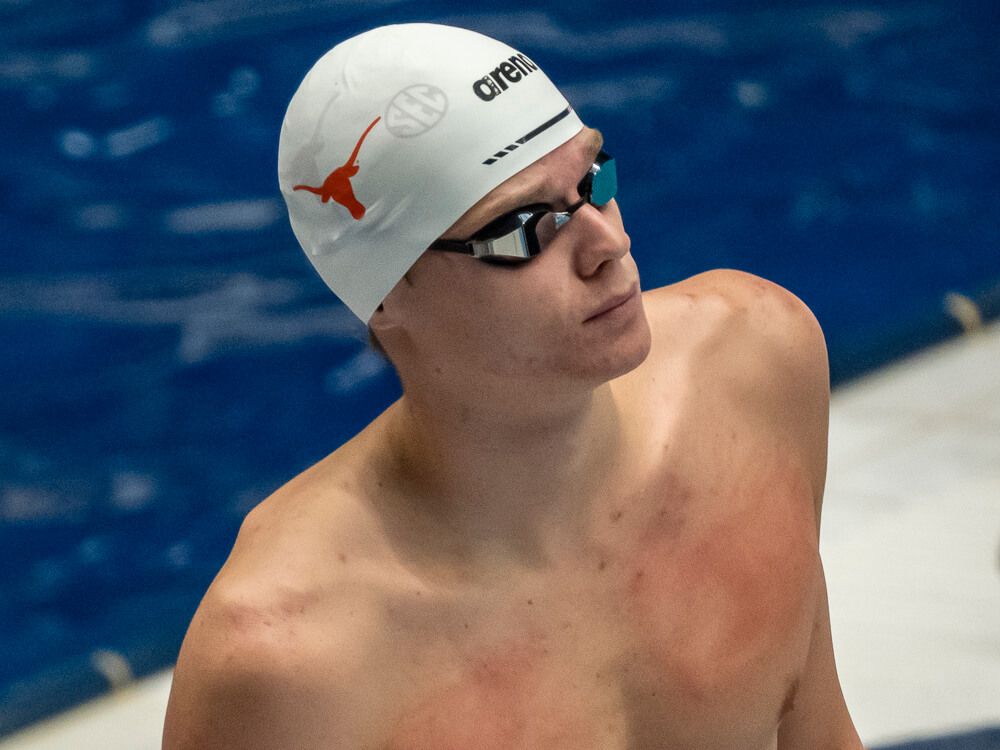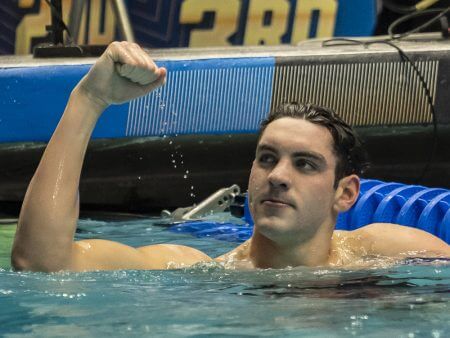Can American Men Use NCAAs as Springboard to Long Course Success?

Can American Men Use NCAAs as Springboard to Long Course?
It’s been almost eight months since a disappointing performance for the U.S. men at the Paris Olympics yielded only six individual medals and a lone gold in the 1500 freestyle from Bobby Finke. Four days of competition passed where no U.S. male swimmers won medals, and no American men made the final of either butterfly event. Of the men responsible for the six medals, two of them — Ryan Murphy and Nic Fink — have been on hiatus from racing since the Games while welcoming their first children.
Moving forward, new star performers for the American men’s team to reclaim its dominant position between now and the 2028 Games to be held on home soil in Los Angeles. Contributions from anywhere would be welcome, but the college ranks look like a promising place to start, particularly with only one of the Olympic medalists, Luke Hobson, younger than 23 years old.
Hobson is an obvious candidate to continue his ascension in the 200 free; since Paris, he has won a short course world title in world-record time, and at the NCAA Championships, he wiped a half-second from his best time in the 200-yard free, a mark which was already the fastest in history. It would be safe to expect continued excellence from Hobson in his main event moving forward.
What other standouts from the NCAA Championships are in position to contribute to the American cause on the international level? Remember, the men’s collegiate winners in seven events were foreigners, and an American record in the 400 medley relay was only good enough for ninth place. So it will not only be U.S. natives using this meet as a springboard for international competitions.
Rex Maurer: The Texas sophomore is the obvious candidate to make a huge jump in long course in 2025. Maurer won the 500 free and 400 IM at the NCAA Championships and finished second in the 1650 free. His breaststroke weakness could prevent him from matching his medley success in the 50-meter pool, but he’s going to contend in mid-distance freestyle. Even without seeing any long course times, he might already be the favorite for the 400-meter free at U.S. Nationals this summer.
His 500-yard American record of 4:04.45 converts to a long course time of 3:39.23, which is quicker than a world record that has lasted almost 16 years and three seconds under the American record. That obviously will not happen, but Maurer could bring welcome speed in an event where no American has won a long course World Championships medal in 12 years. Maurer is also expected to contend for a spot on the U.S. men’s 800 free relay.
Dare Rose: Fourth in the 100 fly and second in the 200 fly at NCAAs, Rose represents by far the best chance for an American medal in butterfly at this year’s World Championships. Rose has already reached the podium at a major meet, earning 100 fly bronze at the 2023 Worlds, but he took a step back last year as he missed the Olympic team by three hundredths. Even without a top-three finish this week, it’s clear he is rebuilding momentum. His 100 fly time of 43.52 marked a drop of almost a second from last season, and he took off more than a half-second from his best in the 200 fly. Coming within a half-second of a national title represents a huge win for a swimmer who benefits greatly from the transition to long course.

Jack Alexy — Photo Courtesy: Peter H. Bick
Jack Alexy & Chris Guiliano: These men are the clear top-two sprinters in the country, even if they were not competitive with the likes of Jordan Crooks and Josh Liendo at NCAAs. They simply do not have the underwaters required to hit the fastest times in history in a short course 50 or 100-yard event, but their results in the 200-yard race are positive signs for the long course 100-meter event. Alexy, in particular, should be a medal contender in the 100 free at Worlds, having won silver in the event in 2023 and clocked a time of 47.08 at last year’s Olympic Trials. Making the race just a little longer benefits him significantly, as evidenced by his win over Crooks in the 100 free at the Short Course World Championships (25-meter pool) in December.
Luca Urlando: A stellar return to college swimming brought Urlando the fastest time ever in the 200 fly in January, and he crushed his own NCAA record in a dominant finale Saturday evening, coming in at 1:36.43. Up against Olympic bronze medalist Ilya Kharun, Urlando jumped on a sizzling pace from the beginning and never allowed anyone to get close. Urlando’s impressive return from shoulder surgery in late 2022 allowed him to earn an Olympic spot in the 200 fly, but he did not advance out of prelims. One would assume that his massive short course drops will translate to the big pool.
Keaton Jones: How about another Cal swimmer whose long course swimming out-rates his short course abilities? Jones was the runnerup in the 200-meter back at last year’s Olympic Trials, and he finished fifth in the event in Paris. While his results from NCAAs were not close to that as he did not qualify for any A-finals, Jones swam times only marginally slower than one year ago on his way to an Olympic berth. His status as a 1:54 200 backstroker will make him a favorite in that event entering the summer season.
Destin Lasco: The best underwater dolphin kicker of any American swimmer racing at the men’s meet, Lasco is coming off a heartbreaking miss at Olympic Trials. He withdrew from his best event, the 200 back, to focus on the 100 free and try to make the Paris team as a relay swimmer. But Lasco fell to seventh in that final, locked out by two tenths. Still, the Trials decision was the right one, with his chances of making the relay stronger than the individual 200 back.
Following the disappointment, Lasco took an extended break from swimming, not racing in the fall, and he did not post any sizzling times during the season. But at NCAAs, he was back to his old form, swimming the best split of his life while helping Cal to a sub-6:00 performance in the 800 free relay. While he did not lower any other best times, he was merely hundredths short of his American record in a runnerup finish in the 200 IM and not far off his backstroke marks. With a 47-second 100 free and a Worlds final in the 200 back to his credit, expect to see Lasco as a continued contender moving forward.
Will Modglin: This 20-year-old Texas sophomore entered college as a short course standout, and that has continued with six A-finals in his first two years with the Longhorns. But he surprised last year by reaching the championship heats of both the 100 back and 200 IM at Olympic Trials. Perhaps not yet, but Modglin bears watching given his year-to-year improvement.
Breaststrokers? The American men have been heavily dependent on Fink in the 100 breast in recent years, but his future in the sport at age 31 with a new child is unclear. Can anyone come out of the college ranks and become a force, both individually and for relay purposes? NCAA-title winner Julian Smith referred to this meet as his last, but maybe fellow sub-50 swimmer Finn Brooks or NCAA third-place finisher Nate Germonprez has something in store. This event could be a significant hole for the U.S. men going forward, both individually and with for medley relays.




I believe the answer to the question is YES! However for American swimmers to be successful at long course as well as 25 yards one should look at the methods that coach Bowman used at Arizona State University in both the undergrad and his pro club group in 2023-2024. He developed and improved swimmers who did well both in NCAAs and in the Olympics by using training methods that featured both LCM and SCY practice and competition throughout the year.